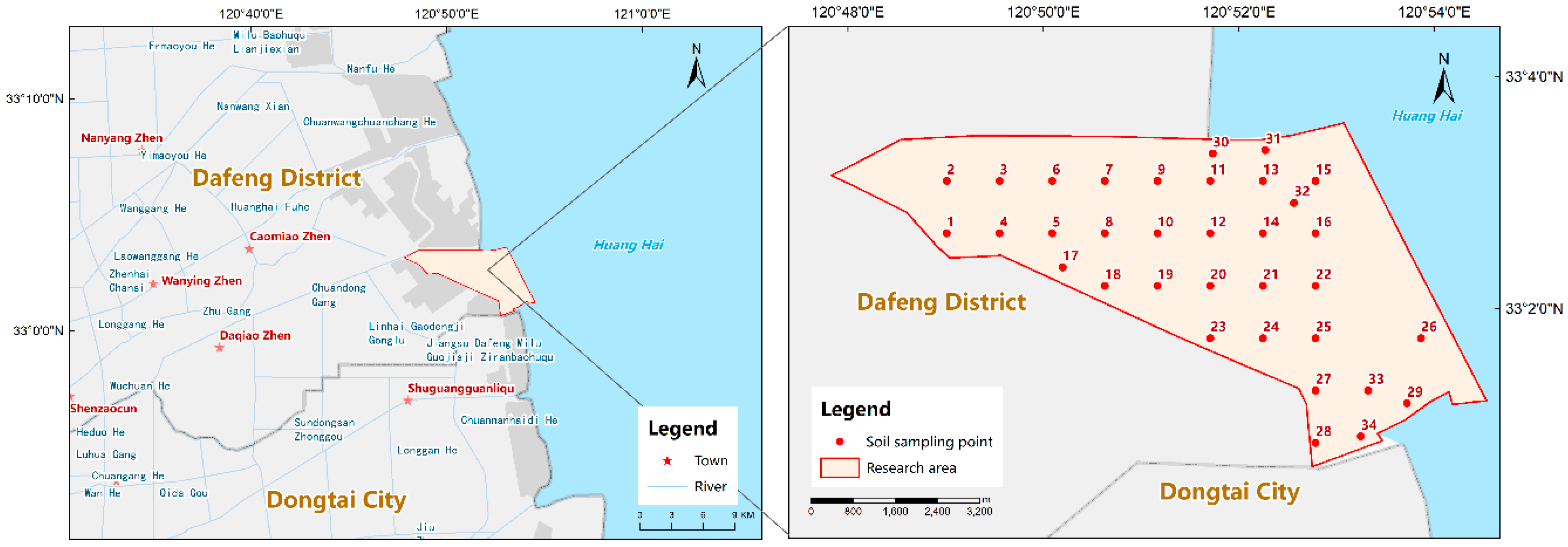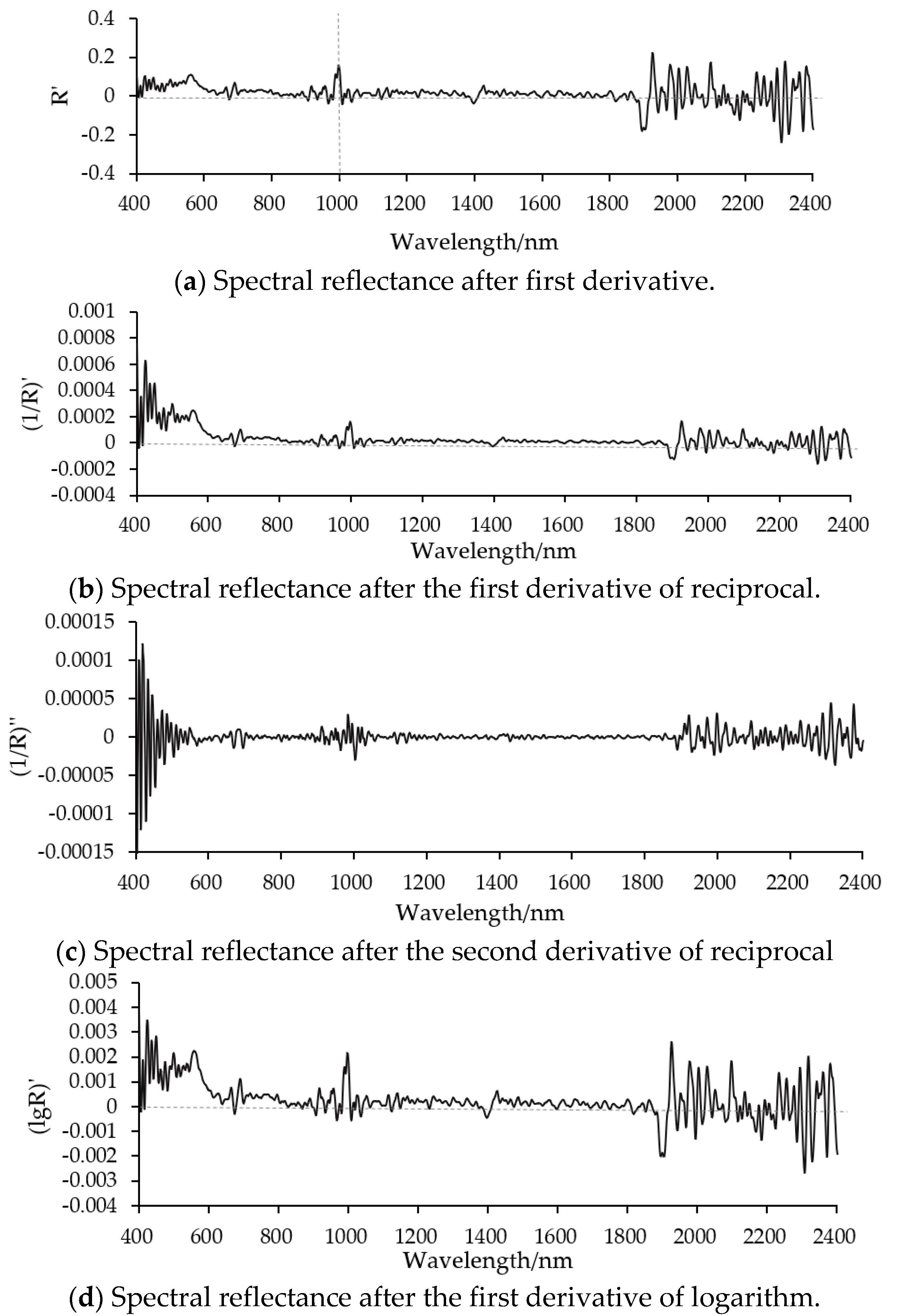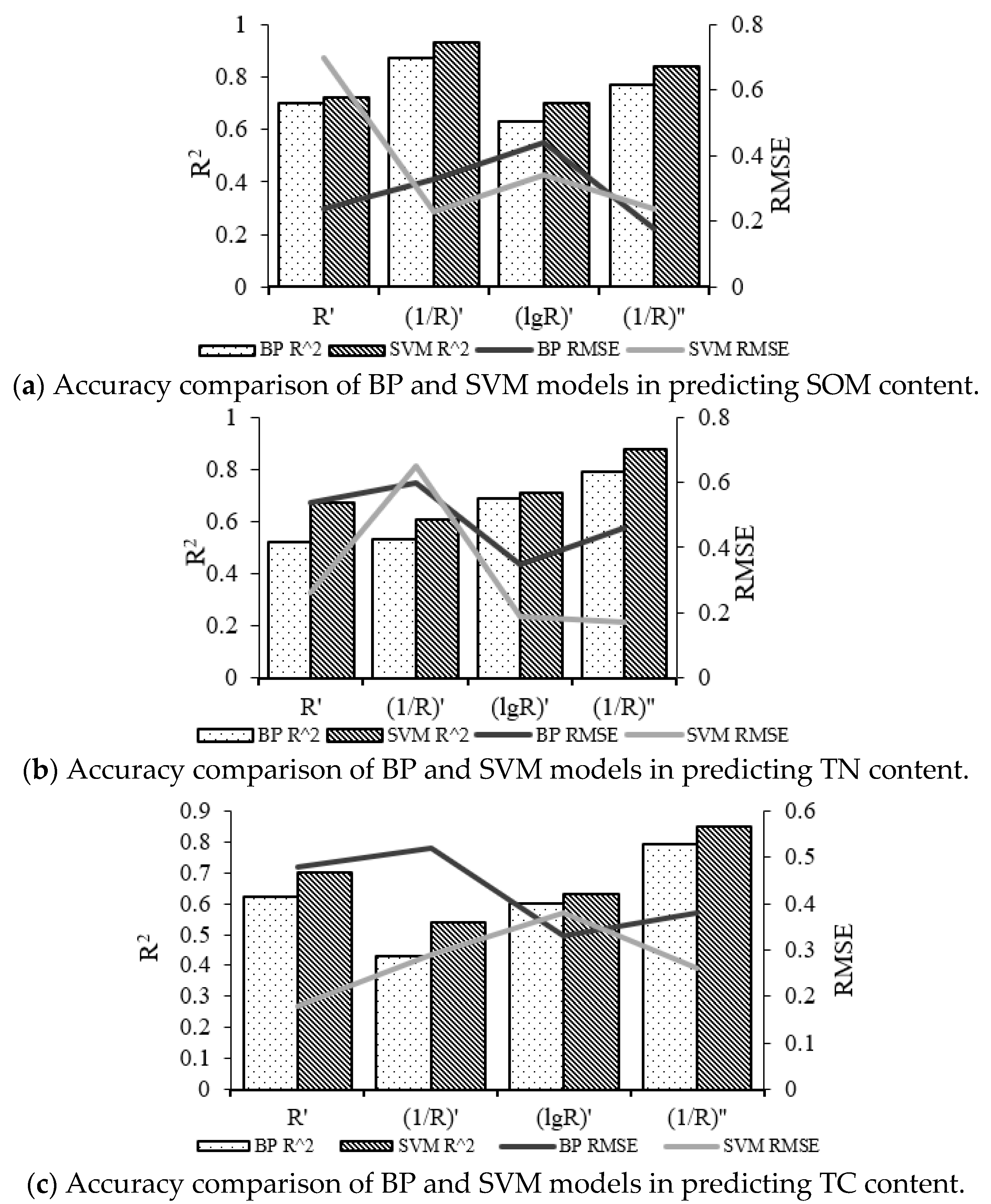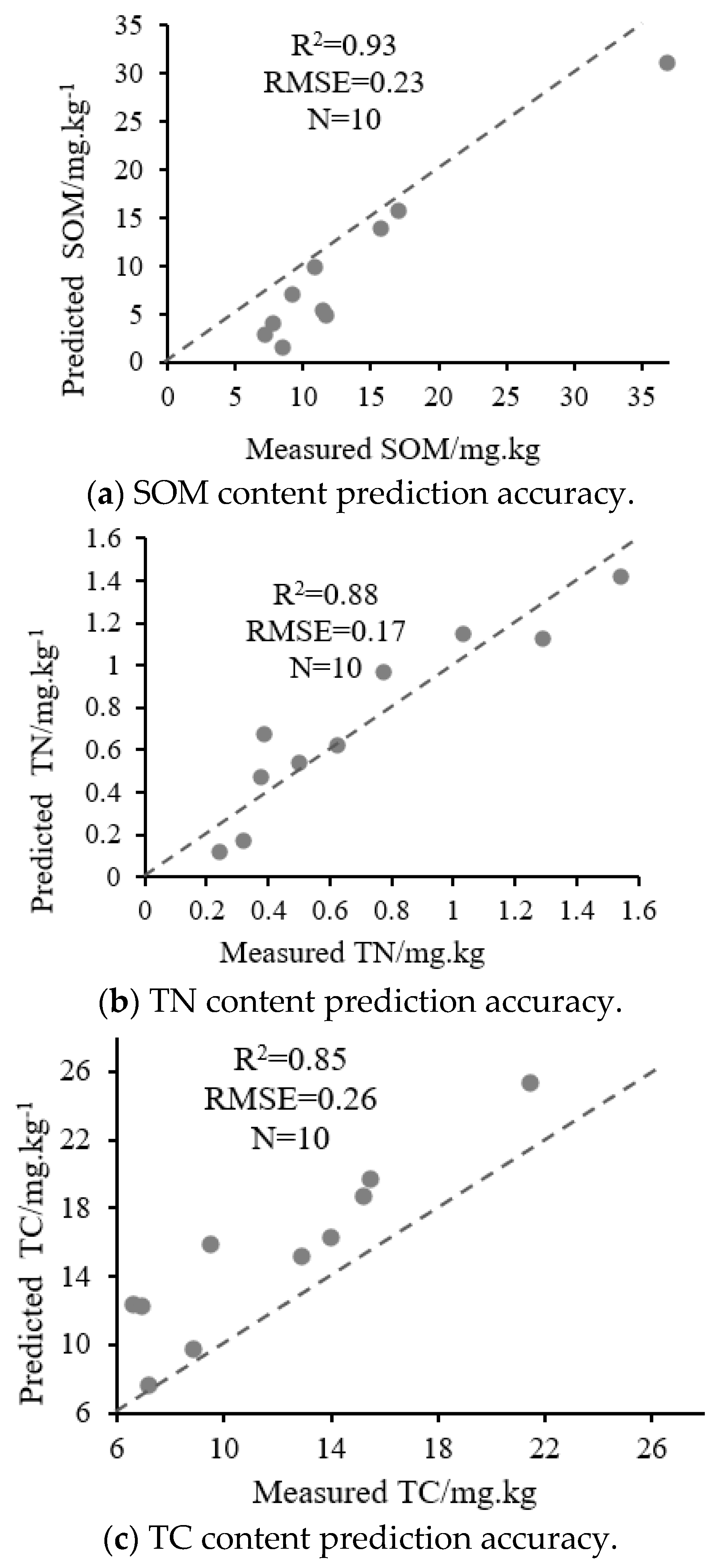Estimation of Soil Organic Matter, Total Nitrogen and Total Carbon in Sustainable Coastal Wetlands
Abstract
1. Introduction
2. Materials and Methods
2.1. Study Area
2.2. Sample Collection
2.3. Reflectance Spectra of Soil Samples
2.4. Analytical Method
3. Results
3.1. Spectral Characteristics of Coastal Wetland Soil
3.2. Extraction of Characteristic Bands of SOM, TN, and TC Contents in Soil
3.3. Model Construction and Accuracy Verification
3.3.1. Hyperspectral Estimation Model of SOM, TN, and TC Content Based on SVM
3.3.2. Hyperspectral Estimation Model of SOM, TN and TC contents Based on BP Neural Network
3.3.3. Accuracy Comparison between SVM and BP for Detecting Soil SOM, TN and TC
4. Discussion
4.1. The Characteristics of Reflectance Spectra for Soils in Coastal Wetland
4.2. The Sensitive Bands and Estimation Accuracy for SOM, TN and TC Contents of Coastal Wetland Soil
5. Conclusions
- (1)
- The model accuracy based on SVM in detecting soil SOM, TN and TC contents is significantly better than that based on the BP neural network.
- (2)
- There is a high correlation between SOM and the reciprocal (1/R)′ of reflectance spectra, the number of bands with significant correlation (p < 0.01) were 13 and the correlation is the highest at 500 nm, the correlation coefficient (R) is −0.484. There is a relative high correlation between TN and the second-order differentials (1/R)″ of reflectance spectra. The number of bands with significant correlation (p < 0.01) was 14, and the highest correlation at 2320 nm is found with correlation coefficient (R) of 0.574. There is also a high correlation between TC and the second-order differentials (1/R)″ of reflectance spectra. There are 24 bands, which are significantly correlated (p < 0.01), and the highest correlation at 2346 nm is determined with the correlation coefficient (R) of 0.579.
- (3)
- The accuracy of the estimation model of SOM based on SVM is the highest, with the prediction coefficient R2 of 0.93 and RMSE of 0.23 mg kg−1, respectively.
- (4)
- In the future, the impact of the numbers of soil samples on the accuracy of the estimation model and root mean square error should be further discussed.
Author Contributions
Funding
Conflicts of Interest
References
- Nadi, M.; Golchin, A.; Sedaghati, E.; Shafie, S.; Hosseini fard, S.J.; Füleky, G. Using Nuclear Magnetic Resonance 1H and 13C in soil organic matter covered by forest. J. Soil Water Conserv. 2017, 21, 83–92. [Google Scholar] [CrossRef]
- Ma, K.; Zhang, Y.; Tang, S.X.; Liu, G. Characteristics of spatial distribution of soil total nitrogen in Zoigen alpine wetland. Chin. J. Ecol. 2016, 35, 1988–1995. [Google Scholar]
- Jauss, V.; Sullivan, P.; Lehmann, J.; Sanderman, J.; Daub, M. Alternative modelling approaches for estimating pyrogenic carbon, soil organic carbon and total nitrogen in contrasting ecoregions within the United States. Geophys. Res. Abstr. 2017, 19, 497. [Google Scholar]
- Lu, X.; Lin, Y.L.; Wu, Y.N.; Gu, Y.; Zhao, Q.; Zhang, X. Spatial Distribution Characteristics of Soil Physical and Chemical Properties in Milu National Nature Reserve of Coastal Wetland. Trans. Oceanol. Limnol. 2018, 4, 74–81. [Google Scholar]
- Vohland, M.; Emmerling, C. Determination of total soil organic C and hot water-extractable C from VIS-NIR soil reflectance with partial least squares regression and spectral feature selection techniques. Soil Sci. 2011, 62, 598–606. [Google Scholar] [CrossRef]
- Wu, D.; Shi, H.; Wang, S.J.; He, Y.; Bao, Y.D.; Liu, K.S. Rapid prediction of moisture content of dehydrated prawns using online hyperspectral imaging system. Anal. Chim. Acta 2012, 726, 57–66. [Google Scholar] [CrossRef] [PubMed]
- Wu, G.F.; He, Y. Application of Wavelet Threshold Denoising Model to Infrared Spectral Signal Processing. Spectrosc. Spectr. Anal. 2009, 29, 3246–3249. [Google Scholar]
- Radim, V.; Radka, K.; Aleš, K.; Luboš, B. Simple but efficient signal pre-processing in soil organic carbon spectroscopic estimation. Geoderma 2017, 298, 46–53. [Google Scholar]
- Shen, Y.; Zhang, X.P.; Liang, A.Z.; Shi, X.H.; Fan, R.Q.; Yang, X.M. Multiplicative scatter correction and step is regression to build NIRS model for analysis of soil Organic Carbon content in black soil. Syst. Sci. Compr. Stud. Agric. 2010, 26, 174–180. [Google Scholar]
- Hu, T.; Qi, K.; Hu, Y. Using vis-nir spectroscopy to estimate soil organic content. In Proceedings of the IGARSS 2018—2018 IEEE International Geoscience and Remote Sensing Symposium, Valencia, Spain, 22–27 July 2018. [Google Scholar]
- Chen, H.Y. Hyperspectral Estimation of Major Soil Nutrient Content. Ph.D. Thesis, Shandong Agricultural University, Shandong, China, 2012. [Google Scholar]
- Sun, W.; Li, X.; Niu, B. Prediction of soil organic carbon in a coal mining area by Vis-NIR spectroscopy. PLoS ONE 2018, 13. [Google Scholar] [CrossRef]
- Chen, H.Y.; Zhao, G.X.; Li, X.C.; Zhu, X.C.; Sui, L.; Wang, Y.J. Hyperspectral estimation of soil organic matter content based on wavelet transformation. Chin. J. Appl. Ecol. 2011, 22, 2935–2942. [Google Scholar]
- Sorenson, P.T.; Small, C.; Tappert, M.C.; Quideau, S.A.; Drozdowski, B.; Underwood, A.; Janzd, A. Monitoring organic carbon, total nitrogen, and pH for reclaimed soils using field reflectance spectroscopy. Can. J. Soil Sci. 2017, 97, 241–248. [Google Scholar] [CrossRef]
- Gao, D.Z.; Zeng, C.S.; Zhang, W.L.; Liu, Q.Q.; Wang, Z.P.; Chen, Y.T. Estimating of soil total nitrogen concentration based on hyperspectral remote sensing data in Minjiang River estuarine wetland. Chin. J. Ecol. 2016, 35, 952–959. [Google Scholar]
- Wu, M.Z.; Li, X.M.; Sha, J.M. Spectral Inversion Model for Prediction of Red Soil Total Nitrogen Content in Subtropical Region (Fuzhou). Spectrosc. Spectr. Anal. 2013, 33, 3111–3115. [Google Scholar]
- He, Y.; Xiao, S.; Nie, P.; Dong, T.; Qu, F.; Lin, L. Research on the Optimum Water Content of Detecting Soil Nitrogen Using Near Infrared Sensor. Sensors 2017, 17, 2045. [Google Scholar] [CrossRef]
- Zhou, X.B.; Zhao, J.W. Methods of Characteristic Wavelength Region and Wavelength Selection Based on Genetic Algorithm. Acta Opt. Sin. 2007, 27, 1316–1321. [Google Scholar]
- Zhang, Y. Research on Spectral Region Selection of Near Infrared Spectra Based on Genetic Algorithm. In Proceedings of the 2017 9th International Conference on Intelligent Human-Machine Systems and Cybernetics (IHMSC), Hangzhou, China, 26–27 August 2017. [Google Scholar]
- Krishnan, P.; Alexander, J.D.; Butler, B.J.; Hummel, J.W. Reflectance Technique for Predicting Soil Organic Matter. Soil Sci. Soc. Am. J. 1980, 44, 1282–1285. [Google Scholar] [CrossRef]
- Tahmasbian, I.; Xu, Z.; Abdullah, K.; Zhou, J.; Esmaeilani, R.; Nguyen, T.T.N.; Bai, S.H. The potential of hyperspectral images and partial least square regression for predicting total carbon, total nitrogen and their isotope composition in forest litterfall samples. J. Soil Sediment. 2017, 17, 2019–2103. [Google Scholar] [CrossRef]
- Couteaux, M.; Berg, B.; Rovira, P. Near infrared reflectance spectroscopy for determination of organic matter fractions including microbial biomass in coniferous forest soils. Soil Biol. Biochem. 2003, 35, 1587–1600. [Google Scholar] [CrossRef]
- Vanwaes, C.; Mestdagh, I.; Lootens, P.; Caflier, L. Possibilities of near infrared reflectance spectroscopy for the prediction of organic carbon concentrations in grassland soils. J. Agric. Sci. 2005, 143, 487–492. [Google Scholar] [CrossRef]
- Heike, G.; Gunter, M.; Hermann, K. Spatially explicit estimation of clay and organic carbon content in agricultural soils using multi-annual imaging spectroscopy data. Appl. Environ. Soil Sci. 2012, 2012, 868090. [Google Scholar]
- Mouazen, A.M.; Maleki, M.R.; Cockx, L.; Meirvenne, M.V.; Holme, L.H.J.V.; Merckx, R.; Baerdemaeker, J.D.; Ramon, H. Optimum three-point linkage set up for improving the quality of soil spectra and the accuracy of soil phosphorus measured using an on-line visible and near infrared sensor. Geoderma 2009, 103, 144–152. [Google Scholar] [CrossRef]
- Jiang, Q.; Li, Q.; Wang, X.; Wu, Y.; Yang, X.; Liu, F. Estimation of soil organic carbon and total nitrogen in different soil layers using VNIR spectroscopy: Effects of spiking on model applicability. Geoderma 2017, 293, 54–63. [Google Scholar] [CrossRef]
- Tian, Y.C.; Zhang, J.J.; Yao, X.; Cao, W.X.; Zhu, Y. Laboratory assessment of three quantitative methods for estimating the organic matter content of soils in China based on visible/near-infrared reflectance spectra. Geoderma 2013, 202–203, 161–170. [Google Scholar] [CrossRef]
- Tang, R.; Chen, K.; Jiang, C.; Li, C. Determining the Content of Nitrogen in Rubber Trees by the Method of NIR Spectroscopy. J. Appl. Spectrosc. 2017, 84, 627–632. [Google Scholar] [CrossRef]
- Liu, X.M.; Liu, J.S. Based on the LS-SVM Modeling Method Determination of Soil Available N and Available K by Using Near Infrared Spectroscopy. Spectrosc. Spectr. Anal. 2012, 32, 3019–3023. [Google Scholar]
- Kennedy, W.; Dieu, T.B.; Øystein, B.D.; Bal, R.S. A comparative assessment of support vector regression, artificial neural networks, and random forests for predicting and mapping soil organic carbon stocks across an Afromontane landscape. Ecol. Indic. 2015, 52, 394–403. [Google Scholar]
- Dalal, R.C.; Henry, R.J. Simultaneous determination of moisture, organic carbon, and total nitrogen by near infrared reflectance spectroscope. Soil Sci. Soc. Am. J. 1986, 50, 120–123. [Google Scholar] [CrossRef]
- Zhang, J.J. Estimating Soil Nutrient Information Based on Spectral Analysis Technology. Ph.D. Thesis, Nanjing Agricultural University, Nanjing, China, 2009. [Google Scholar]
- Yu, L.; Hong, Y.S.; Geng, L.; Zhou, Y.; Zhu, Q.; Cao, J.J.; Nie, Y. Hyperspectral estimation of soil organic matter content based on partial least squares regression. Trans. Chin. Soc. Agric. Eng. 2015, 31, 103–109. [Google Scholar]
- Bao, N.S.; Wu, L.X.; Ye, B.Y.; Yang, K.; Zhou, W. Assessing soil organic matter of reclaimed soil from a large surface coal mine using a field spectroradiometer in laboratory. Geoderma 2017, 288, 47–55. [Google Scholar] [CrossRef]
- Zhang, H.L.; Liu, X.M.; He, Y. Measurement of Soil Organic Matter and Available K Based on SPA-LS-SVM. Spectrosc. Spectr. Anal. 2014, 34, 1348–1351. [Google Scholar]
- Huete, A.R. Estimation of soil properties using hyperspectral VIS/IR sensors. Encycl. Hydrol. Sci. 2006, 15, 887–901. [Google Scholar]
- Kooistra, L.; Salas, E.A.L.; Clevers, J.G.P.W.; Wehrens, R.; Leuven, R.S.E.W.; Nienhuis, P.H.; Buydens, L.M.C. Exploring field vegetation reflectance as an indicator of soil contamination in river floodplains. Environ. Pollut. 2004, 127, 281–290. [Google Scholar] [CrossRef]
- Wang, X.P.; Zhang, F.; Kung, H.; Verner, C.J. New methods for improving the remote sensing estimation of soil organic matter content (SOMC) in the Ebinur Lake Wetland National Nature Reserve (ELWNNR) in northwest China. Remote Sens. Environ. 2018, 218, 104–118. [Google Scholar] [CrossRef]
- Liu, J.G.; Xue, J.H.; Wang, L.; Ding, J.J.; Wang, W.L.; Liu, C.G.; Rong, Y. Habitat degradation features of Pere David’s Deer Natural Reserve in Dafeng of Jiangsu Province, East China. Chin. J. Ecol. 2011, 30, 1793–1798. [Google Scholar]
- Ye, Z.G. Research on Nutrient Evolution in BoZhou Tillage. Master’s Thesis, Anhui Agricultural University, Hefei, China, 2007. [Google Scholar]
- Li, G.H.; Ye, X.L.; Yang, S.; Wen, Y.J.; Huang, J.S.; Liu, Y.X.; Wang, H. Comparison of total soil carbon determination by catalytic oxidation method and direct combustion method. Soil Fertil. Sci. China 2014, 4, 97–101. [Google Scholar]
- Zhang, Q.; Zhang, G.L.; Zhang, Z.; Lv, X. Predicting of Soil Total Nitrogen Content Based on Hyperspectral Data. J. Shanxi Agric. Sci. 2016, 44, 972–976. [Google Scholar]
- Tian, Y.; Shen, R.P.; Ding, G.X. Application of Support Vector Machine on Soil Magnesium Content Estimation Based on Hyper-Spectra. Soils 2015, 47, 602–607. [Google Scholar]
- Cécile, G.; Raphael, A.; Viscarra, R.; Alex, B.M.B. Soil organic carbon prediction by hyperspectral remote sensing and field vis-NIR spectroscopy: An Australian case study. Geoderma 2008, 146, 403–411. [Google Scholar]
- Li, Y.M.; Wang, Q.; Huang, J.Z. Ground Remote Sensing Experiment Principles and Methods; Science Press: Beijing, China, 2011. [Google Scholar]
- Wang, L.; Zhu, X.C.; Liu, Q.; Zhao, G.X.; Liu, H.Y.; Wang, L.; Zhang, S.W. Hypersperpectral Quantitative Estimation of Saline-alkali Soil Salinity in the Yellow River Delta. Chin. J. Soil Sci. 2013, 44, 1101–1106. [Google Scholar]
- Zhang, J.J.; Tian, Y.C.; Yao, X.; Cao, W.X.; Ma, X.M.; Zhu, Y. Estimating Soil Total Nitrogen Content Based on Hyperspectral Analysis Technology. J. Natl. Resour. 2011, 26, 881–890. [Google Scholar]
- Yang, Y. Hyperspectral Inversion of Soil Total Nitrogen, Total Carbon and Carbon-Oxygen Ratio in Sanjiangyuan District. Master’s Thesis, Qinghai University, Qinghai, China, 2014. [Google Scholar]
- Zhang, X.Q. Discussion on the Evolution of Coastal Wetland and the Construction Mode of Nature Reserve in Yancheng, Jiangsu Province; Shandong People’s Publishing House: Jinan, China, 2013; p. 35. [Google Scholar]
- Jiang, L.L.; Zhang, Y.; Wang, Y.Y.; Tan, L.H.; He, Y. Fast determination of nutritional parameters in soil based on spectroscopic techniques. J. Zhejiang Univ. 2010, 36, 445–450. [Google Scholar]
- Liu, X.M. Near infrared diffuse reflectance spectra detection of soil organic matter and available N. J. Chin. Agric. Mech. 2013, 34, 202–206. [Google Scholar]
- Antonios, M.; Xanthoula, E.P.; Dimitrios, M.; Thomas, A.; Rebecca, W.; Georgios, T.; Jens, W.; Ralf, B.; Abdul, M.M. Machine learning based prediction of soil total nitrogen, organic carbon and moisture content by using VIS-NIR spectroscopy. Biosyst. Eng. 2016, 152, 104–116. [Google Scholar]






| Property | Min | Max | SD | Mean | CV |
|---|---|---|---|---|---|
| SOM (mg kg−1) | 7 | 45.3 | 8.3 | 13.2 | 63.1 |
| TN (mg kg−1) | 0.24 | 2.08 | 0.4 | 0.7 | 55.8 |
| TC (mg kg−1) | 4.2 | 34.8 | 7.0 | 14 | 50.8 |
| Elements | Transformation | Maximum Correlation | Minimum Correlation | Number | Sensitive Band nm (p < 0.01) | ||
|---|---|---|---|---|---|---|---|
| Band nm | R | Band nm | R | ||||
| SOM | R′ | 855 | 0.468 ** | 2213 | −0.402 * | 2 | 855, 854 |
| (1/R)′ | 2324 | 0.479 ** | 500 | −0.484 ** | 13 | 498–501, 1180–1182, 1946, 1947, 2323–2326 | |
| (lgR)′ | 855 | 0.441 ** | 534 | −0.465 ** | 3 | 533, 534, 855 | |
| (1/R)″ | 900 | 0.477 ** | 1952 | −0.425 * | 7 | 874, 899, 900, 901, 2319, 2320, 2346 | |
| TN | R′ | 1291 | 0.543 ** | 1358 | −0.442 * | 21 | 514, 515, 785–790, 854–856, 1290–1293, 1358, 1359, 1493–1496 |
| (1/R)′ | 2325 | 0.547 ** | 500 | −0.558 ** | 46 | 496–502, 523–525, 530–534, 1179–1184, 1239–1243, 1268, 1291, 1292, 1358–1360, 1426–1428, 1947, 1948, 2323–2327, 2339–2342 | |
| (1/R)″ | 2320 | 0.574 ** | 1177 | −0.472 ** | 14 | 536, 900, 1177, 1178, 1285–1287, 1977, 2319–2322, 2345, 2346 | |
| (lgR)′ | 1291 | 0.502 ** | 1359 | −0.458 ** | 25 | 786–789, 855, 856, 1181, 1182, 1241, 1242, 1290–1293, 1358–1360, 1494, 1947, 1948, 2324–2326, 2340, 2341 | |
| TC | R′ | 1946 | 0.538 ** | 2368 | −0.474 ** | 42 | 479, 480, 642–644, 689–691, 726–732, 785–791, 990–996, 1798–1801, 1943–1948, 2367–2369 |
| (1/R)′ | 1946 | 0.569 ** | 1240 | −0.521 ** | 49 | 494–501, 531–534, 638–644, 696, 697, 1179–1184, 1238–1244, 1799, 1800, 1801, 1930, 1931, 1943–1948, 2340–2342, 2367 | |
| (1/R)″ | 2346 | 0.579 ** | 1951 | −0.538 ** | 24 | 536, 537, 561, 562, 619–622, 899, 900, 1234, 1235, 1438, 1439, 1795, 1796, 1949–1952, 2345–2347, 2373 | |
| (lgR)′ | 1945 | 0.559 ** | 1240 | −0.488 ** | 37 | 479, 480, 639–644, 696, 697, 728, 785–791, 993, 994, 1239–1242, 1358, 1798–1801, 1943–1948, 2367, 2368 | |
| Elements | Variable | Estimation model | Validation Model | ||
|---|---|---|---|---|---|
| R2 | RMSE | R2 | RMSE | ||
| SOM | R′ | 0.74 ** | 0.39 | 0.72 ** | 0.7 |
| (1/R)′ | 0.68 ** | 0.28 | 0.93 ** | 0.23 | |
| (lgR)′ | 0.89 ** | 0.18 | 0.7 ** | 0.34 | |
| (1/R)″ | 0.84 ** | 0.32 | 0.84 ** | 0.24 | |
| TN | R′ | 0.74 ** | 0.37 | 0.67 ** | 0.26 |
| (1/R)′ | 0.63 ** | 0.31 | 0.61 ** | 0.65 | |
| (lgR)′ | 0.76 ** | 0.24 | 0.71 ** | 0.19 | |
| (1/R)″ | 0.87 ** | 0.27 | >0.88 ** | 0.17 | |
| TC | R′ | 0.64 ** | 0.31 | 0.7 ** | 0.18 |
| (1/R)′ | 0.57 ** | 0.4 | 0.54 * | 0.29 | |
| (lgR)′ | 0.82 ** | 0.22 | 0.63 ** | 0.38 | |
| (1/R)″ | 0.86 ** | 0.23 | 0.85 ** | 0.26 | |
| Elements | Variable | Estimation model | Validation Model | ||
|---|---|---|---|---|---|
| R2 | RMSE | R2 | RMSE | ||
| SOM | R′ | 0.89 ** | 0.26 | 0.7 ** | 0.24 |
| (1/R)′ | 0.83 ** | 0.09 | 0.87 ** | 0.33 | |
| (lgR)′ | 0.95 ** | 0.02 | 0.63 ** | 0.44 | |
| (1/R)″ | 0.66 * | 0.06 | 0.77 ** | 0.18 | |
| >TN | R′ | 0.85 ** | 0.08 | 0.52 * | 0.54 |
| (1/R)′ | 0.82 ** | 0.09 | 0.53 * | 0.6 | |
| (lgR)′ | 0.82 ** | 0.04 | 0.69 ** | 0.35 | |
| (1/R)″ | 0.85 ** | 0.05 | 0.79 ** | 0.46 | |
| TC | R′ | 0.86 ** | 0.13 | 0.62 ** | 0.48 |
| (1/R)′ | 0.93 ** | 0.03 | 0.43 * | 0.52 | |
| (lgR)′ | 0.9 ** | 0.04 | 0.6 ** | 0.33 | |
| (1/R)″ | 0.6 * | 0.19 | 0.79 ** | 0.38 | |
© 2019 by the authors. Licensee MDPI, Basel, Switzerland. This article is an open access article distributed under the terms and conditions of the Creative Commons Attribution (CC BY) license (http://creativecommons.org/licenses/by/4.0/).
Share and Cite
Zhang, S.; Lu, X.; Zhang, Y.; Nie, G.; Li, Y. Estimation of Soil Organic Matter, Total Nitrogen and Total Carbon in Sustainable Coastal Wetlands. Sustainability 2019, 11, 667. https://doi.org/10.3390/su11030667
Zhang S, Lu X, Zhang Y, Nie G, Li Y. Estimation of Soil Organic Matter, Total Nitrogen and Total Carbon in Sustainable Coastal Wetlands. Sustainability. 2019; 11(3):667. https://doi.org/10.3390/su11030667
Chicago/Turabian StyleZhang, Sen, Xia Lu, Yuanzhi Zhang, Gege Nie, and Yurong Li. 2019. "Estimation of Soil Organic Matter, Total Nitrogen and Total Carbon in Sustainable Coastal Wetlands" Sustainability 11, no. 3: 667. https://doi.org/10.3390/su11030667
APA StyleZhang, S., Lu, X., Zhang, Y., Nie, G., & Li, Y. (2019). Estimation of Soil Organic Matter, Total Nitrogen and Total Carbon in Sustainable Coastal Wetlands. Sustainability, 11(3), 667. https://doi.org/10.3390/su11030667




